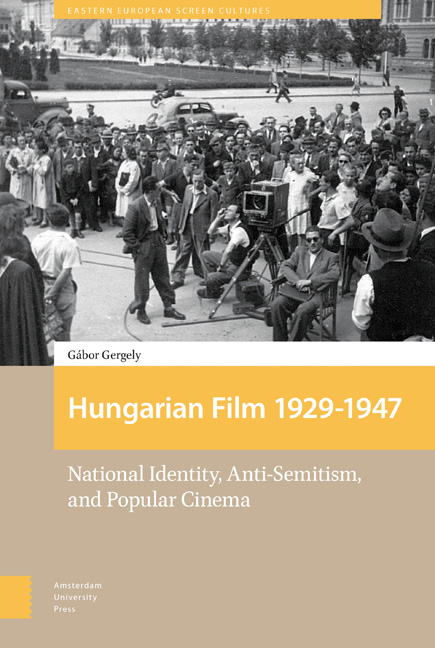Book contents
- Frontmatter
- Dedication
- Contents
- List of Illustrations
- Acknowledgements
- A Note on Accents, Pronunciation, Names, and Spellings
- Preface
- Introduction
- 1 Key Concepts in Pre-1945 Hungarian Cinema
- 2 A Contested Film History
- 3 An Industry Emerges 1931-1935
- 4 Boom, Crisis and Anti-Semitic Reorganization 1936-1941
- 5 From War Boom to Bust 1941-1944
- Epilogue: Industry Reboot and the Myth of a New Start 1945-1947
- Concluding Remarks
- Bibliography
- Index
3 - An Industry Emerges 1931-1935
Published online by Cambridge University Press: 11 December 2020
- Frontmatter
- Dedication
- Contents
- List of Illustrations
- Acknowledgements
- A Note on Accents, Pronunciation, Names, and Spellings
- Preface
- Introduction
- 1 Key Concepts in Pre-1945 Hungarian Cinema
- 2 A Contested Film History
- 3 An Industry Emerges 1931-1935
- 4 Boom, Crisis and Anti-Semitic Reorganization 1936-1941
- 5 From War Boom to Bust 1941-1944
- Epilogue: Industry Reboot and the Myth of a New Start 1945-1947
- Concluding Remarks
- Bibliography
- Index
Summary
Before the Sound: Silents
One of the enduring myths about Hungarian cinema is that there was no such thing until the advent of sound. In the accepted narrative of Hungarian film scholarship, the brain drain that followed the Red and White Terrors of 1919-1920 was fatal. According to Nemeskürty, the filmmaking boom of the Hungarian Soviet Republic was followed by ‘Dead Silence’ (1974, 55-68). As usual, Nemeskürty exaggerates for effect and skims over detail to suit his purpose: over 80 films were made and released between 1919 and 1930. Hardly ‘dead silence’! It is true, however, that a remarkably lively industry, which made 36 films in 1918, shrunk at an alarming rate during the 1920s until it hit a low point of turning out just a handful of films each year between 1925 and 1931. The brain drain or the Horthy regime's hostility to filmmakers (Nemeskürty 1974, 55) were not the primary causes of this decline. In fact, the new regime identified cinema early on as an area of strategic significance and, for the first time, the film sector attracted much attention from the state. The major factor behind the sharp drop in output was the Trianon Treaty, which resulted in a complete economic meltdown from which no industry was exempt. Writing at a time when Trianon was taboo, however, Nemeskürty places the blame on Horthy and the emigration of filmmakers.
Despite the influx of American, British, French, Italian, and, later, German films in the 1920s (Balogh et al. 2004, 40), Hungarian filmmakers continued to make efforts to recover at least a small segment of the market for the domestic product. That they were unsuccessful was not because they were talentless, as Nemeskürty suggests (1974, 55-56). The audience had lapped up everything that the industry produced in the war years. It was precisely an abundance of demand, with a seeming disregard for quality, that had made room for the experimentation necessary for the development of a viable industry in Hungary. As noted above, it was not even for lack of state involvement that the Hungarian industry languished. The Magyar Film Iroda (Hungarian Film Office) was established in 1924 to make newsreels and educational short films (Balogh et al. 2004, 40).
- Type
- Chapter
- Information
- Hungarian Film, 1929–1947National Identity, Anti-Semitism and Popular Cinema, pp. 99 - 144Publisher: Amsterdam University PressPrint publication year: 2017

